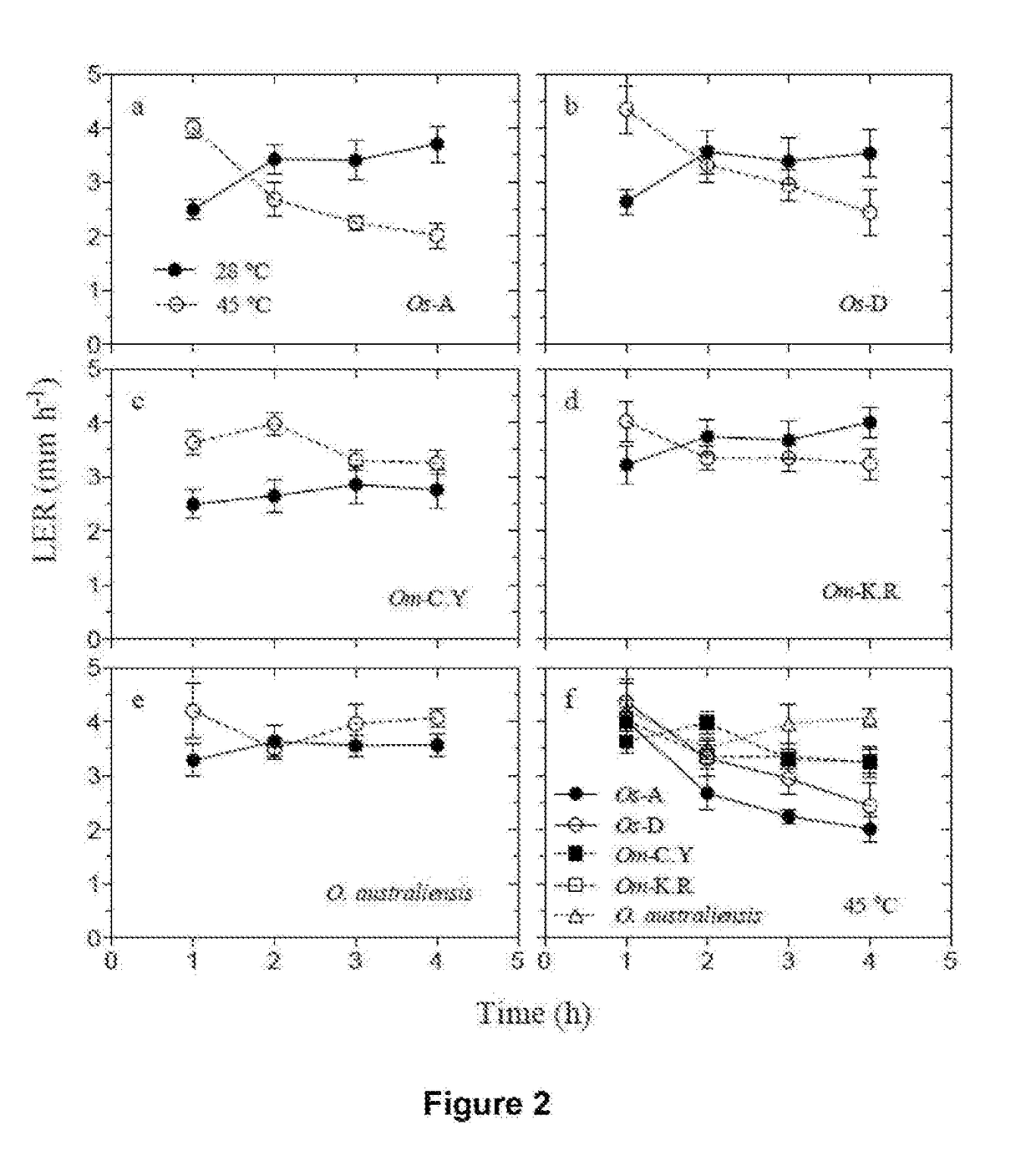Thermostable rubisco activase complexes
a technology of rubisco activase and complexes, which is applied in the direction of lyases, carbon-carbon lyases, peptide sources, etc., can solve the problems of cosub>2 /sub>fixation decline, and achieve the effect of enhancing heat tolerance in the plan
- Summary
- Abstract
- Description
- Claims
- Application Information
AI Technical Summary
Benefits of technology
Problems solved by technology
Method used
Image
Examples
example 1
ncing and Sequence Alignment
[0115]Initially total RNA was extracted from 100 mg of leaf tissue using an RNeasy Plant Mini Kit (Qiagen). RNA was converted to cDNA using a SuperScript VILO cDNA Synthesis Kit (Invitrogen) using 2.1 μg of RNA as a template. PCR was performed on 2 μl of the cDNA product using GoTaq Green Master Mix (Promega). Refer to Supplementary Methods in Scafaro, A. P., Haynes, P. A. & Atwell, B. J. (2010) J. Exp. Bot. 61, 191-202 for the PCR cycle program and the primers used. The product was run on a 1.5% agarose gel stained with Gel Red (Biotium). The bands where cut from the gel using a scalpel and the DNA purified using a DNA Gel Extraction Kit (Qiagen). The PCR products were sequenced in both directions using the same primers as PCR amplification. Sequence preparation was performed using Big Dye Terminator V3.1 sequencing reaction mix as per manufacturer's instructions and samples run on a 3130×1 Genetic Analyzer (Applied Biosystems, Foster City, Calif., USA)....
example 3
Rubisco and RCA Stoichiometry
[0133]Rubisco and RCA concentration was determined by Western Blot analysis of extracted total soluble leaf protein calibrated against purified Rubisco and RCA of known concentration.
[0134]To determine in vivo concentrations of the two enzymes, standard curves were generated using purified enzyme of known concentration. The concentration of Rubisco was determined using an antibody specific for the 53 kDa large subunit of Rubisco. Because the quaternary structure of the Rubisco complex comprises 8 large and 8 small (16 kDa) subunits, the total Rubisco content could be deduced from these westerns. Table 4 lists the concentrations of Rubisco and RCA for the two species and the ratio between the two functionally complete enzymes. While there was substantial variation between biological and technical replicates using this indirect method, there was no evidence for statistically differences between the species. However, in the absence of a more precise techniq...
example 4
ntration-Dependent Oligomer Formation (Native Gels)
[0135]Native gel analysis has allowed for the concentration-dependent self-oligomerisation of RCA subunits to be observed. To the inventors' knowledge this is the first time native gels have been used to visualise the interaction of RCA subunits. Others have shown similar RCA self-assembly in cotton and tobacco using fluorescence and small angle X-ray scattering techniques (Henderson, J. N., Hazra, S., Dunkle, A. M., Salvucci, M. E. & Wachter, R. M. (2013) Biochimica et Biophysica Acta (BBA)—Proteins and Proteomics 1834, 87-97; Wachter, R. et al. (2013) Photosynthesis Res. 117, 557-566.). Similarly, O. australiensis (Oa) and O. sativa (Os) RCA form a larger complex through self-association when the enzyme concentration is increased. The inhibition of activation activity at low RCA concentrations is a result of the self-associating complex falling below a certain threshold of about three RCA subunits. Note that due to differences in ...
PUM
| Property | Measurement | Unit |
|---|---|---|
| Fraction | aaaaa | aaaaa |
| Fraction | aaaaa | aaaaa |
| Fraction | aaaaa | aaaaa |
Abstract
Description
Claims
Application Information
 Login to View More
Login to View More - R&D
- Intellectual Property
- Life Sciences
- Materials
- Tech Scout
- Unparalleled Data Quality
- Higher Quality Content
- 60% Fewer Hallucinations
Browse by: Latest US Patents, China's latest patents, Technical Efficacy Thesaurus, Application Domain, Technology Topic, Popular Technical Reports.
© 2025 PatSnap. All rights reserved.Legal|Privacy policy|Modern Slavery Act Transparency Statement|Sitemap|About US| Contact US: help@patsnap.com



